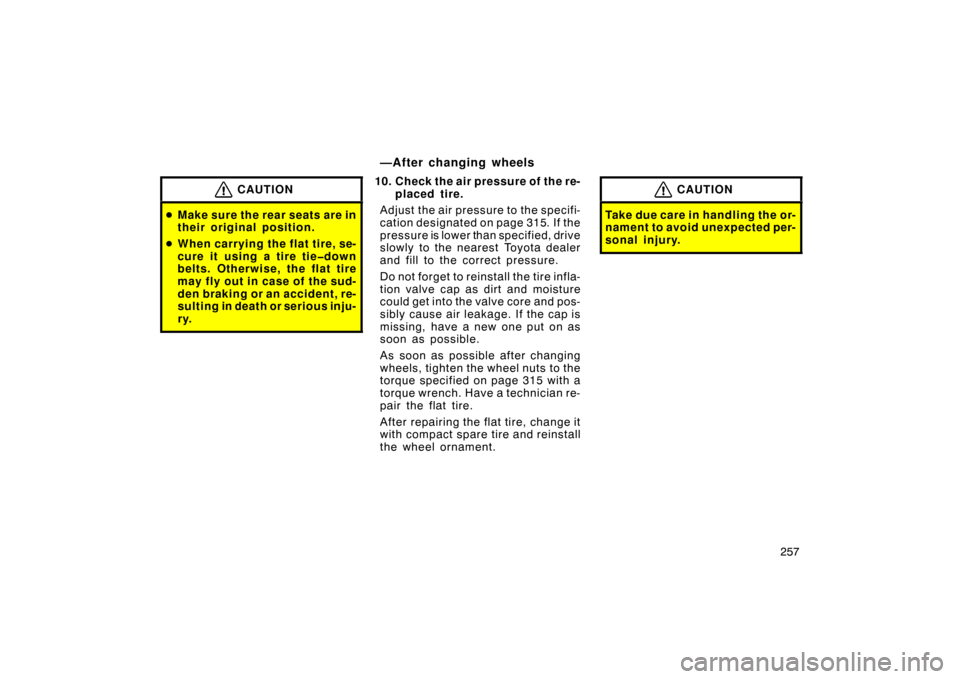Page 225 of 336

225
Ti r e relat ed ter m
Meaning
Cold tire inflation pressuretire inflation pressure when the vehicl
e has been parked at least 3 hours or
more, or it has not been driven more t han 1.5 km or 1 mile under that condition
Maximum inflation pressurethe maximum cold inflation pressure to which a tire may be inflated and shown
on the sidewall of the tire
Recommended inflation pressurecold tire inflation pressure recommended by a manufacturer
Accessory weight
the combined weight (in excess of those standard items which may be replaced)
of automatic transmission, power steering, power brakes, power windows, pow-
er seats, radio, and heater, to the extent that these items are available as
factory−installed equipment (whether installed or not)
Curb weight
the weight of a motor vehicle with standard equipment including the maximum
capacity of fuel, oil, and coolant, and, if so equipped, air conditioning and addi-
tional weight optional engine
Maximum loaded vehicle weight
t he sum of —
(a) curb weight;
(b) accessory weight;
(c) vehicle capacity weight; and
(d) production options weight
Normal occupant weight68 kg (150 lb.) times the number of occupants specified in the second column
of Table 1 that follows
—Glossary of tire terminology
Page 229 of 336

229
�Never allow anyone to ride in
the luggage compartment. It is
not designed for passengers.
They should ride in their seats
with their seat belts properly
fastened. Otherwise, they are
much more likely to suffer seri-
ous bodily injury, in the event
of sudden braking or a colli-
sion.
� Do not place anything on the
luggage cover. Such items may
be thrown about and possibly
injure people in the vehicle
during sudden braking or an
accident. Secure all items in a
safe place.
� Do not drive with objects left
on top of the instrument panel.
They may interfere with the
driver’s field of view. Or they
may move during sharp vehicle
acceleration or turning, and im-
pair the driver’s control of the
vehicle. In an accident they
may injure the vehicle occu-
pants.NOTICE
Do not load the vehicle beyond
the vehicle capacity weight giv-
en in Section 9.
Cargo capacity depends on the to-
tal weight of the occupants.
(Cargo capacity) = (Total load capac-
ity) – (Total weight of occupants)
STEPS FOR DETERMINING COR-
RECT LOAD LIMIT
1. Locate the statement “The com- bined weight of occupants and car-
go should never exceed XXX
pounds” on your vehicle’s placard.
2. Determine the combined weight of the driver and passengers that will
be riding in your vehicle.
3. Subtract the combined weight of the driver and passengers from
XXX kilograms or XXX pounds.
—Capacity and distribution
Page 257 of 336

257
CAUTION
�Make sure the rear seats are in
their original position.
� When carrying the flat tire, se-
cure it using a tire tie�down
belts. Otherwise, the flat tire
may fly out in case of the sud-
den braking or an accident, re-
sulting in death or serious inju-
ry.
10. Check the air pressure of the re-
placed tire.
Adjust the air pressu re to the specifi-
cation designated on page 315. If the
pressure is lower than specified, drive
slowly to the nearest Toyota dealer
and fill to the correct pressure.
Do not forget to reinstall the tire infla-
tion valve cap as dirt and moisture
c ould get int o t he valv e cor e a nd pos-
sibly cause air leakage. If the cap is
missing, have a new one put on as
soon as possible.
As soon as possible after changing
wheels, tighten the wheel nuts to the
torque specified on page 315 with a
torque wrench. Have a technician re-
pair the flat tire.
After repairing the flat tire, change it
with compact spare tire and reinstall
the wheel ornament.CAUTION
Take due care in handling the or-
nament to avoid unexpected per-
sonal injury.
—After changing wheels
Page 274 of 336

274
INSIDE THE VEHICLE
Items listed below should be checked
regularly, e.g. while performing periodic
services, cleaning the vehicle, etc.
Lights
Make sure the headlights, stop lights, tail
lights, turn signal lights, and other lights
are all working. Check headlight aim.
Service reminder indicators and warning
buzzers
Check that all service reminder indicators
and warning buzzers function properly.
Steering wheel
Be alert for changes in steering condition,
such as hard steering or strange noise.
Seats
Check that all front seat controls such as
seat adjusters, seatback recliner, etc. op-
erate smoothly and that all latches lock
securely in any position. Check that the
head restraint move up and down smooth-
ly and that the locks hold securely in any
latched position.Seat belts
Check that the seat belt system such as
buckles, retractors and anchors operate
properly and smoothly. Make sure the belt
webbing is not cut, frayed, worn or dam-
aged.
Accelerator pedal
Check the pedal for smooth operation and
uneven pedal effort or catching.
Brake pedal
Check the pedal for smooth operation and
that the pedal has the proper clearance.
Check the brake booster function.
Brakes
In a safe place, check that the brakes do
not pull to one side when applied.
Parking brake
Check that the pedal has the proper travel
and that, on a safe incline, your vehicle
is held securely with only the parking
brake applied.
OUTSIDE THE VEHICLE
Items listed below should be performed
from time to time, unless otherwise
specified.
Fluid leaks
Check underneath for leaking fuel, oil, wa-
ter or other fluid after the vehicle has
been parked for a while. If you smell fuel
fumes or notice any leak, have the cause
found and corrected immediately.
Doors and engine hood
Check that all doors and trunk operate
smoothly and all latches lock securely.
Make sure the engine hood secondary
latch secures the hood from opening when
the primary latch is released.
Tire inflation pressure
Check the pressure with a gauge ev-
ery two weeks, or at least once a
month. See page 291 for additional
information.
Page 323 of 336

323
Occupant restraint sys-tems
Toyota encourages you and your
family to take the time to read
Section 2−2 of this Owner’s Manu-
al carefully. In terms of helping
you understand how you can re-
ceive the maximum benefit of the
occupant restraint systems this ve-
hicle provides, Section 2 −2 of this
Owner ’s Manual is the most im-
portant section for you and your
family to read.
Section 2 −2 describes the function
and operation concerning seats,
seat belts, SRS airbags and child
restraint systems of this vehicle
and some potential hazards you
should be aware of. These sys-
tems work together along with the
overall structure of this vehicle in
order to provide occupant restraint
in the event of a crash. The effect
of each system is enhanced when
it is used properly and together
with other systems. No single oc-
cupant restraint system can, by it-
self, provide you or your family
with the equal level of restraint
which these systems can provide
when used together. That is why it
is important for you and your fam-
ily to understand the purpose and
proper use of each of these sys-
tems and how they relate to each
other.
The purpose of all occupant re-
straint systems is to help reduce
the possibility of death or serious
injury in the event of a collision.
None of these systems, either in-
dividually or together, can ensure
that there is no injury in the event
of collision. However, the more
you know about these systems
and how to use them properly, the
greater your chances become of
surviving an accident without death
or serious injury.
Seat belts provide the primary re-
straint to all occupants of the ve-
hicle, and every occupant of the
vehicle should wear seat belts
properly at all times. Children
should always be secured in child
restraint systems that are ap-
propriate for their age and size.
SRS (Supplemental Restraint Sys-
tem) airbags are, as their names
imply, designed to work with, and
be supplemental to, seat belts and
are not substitutes for them. SRS
airbags can be very effective in
reducing the risk of head and
chest injuries by preventing con-
tact of the head and chest with
interior portions of the vehicle.
Page:
< prev 1-8 9-16 17-24